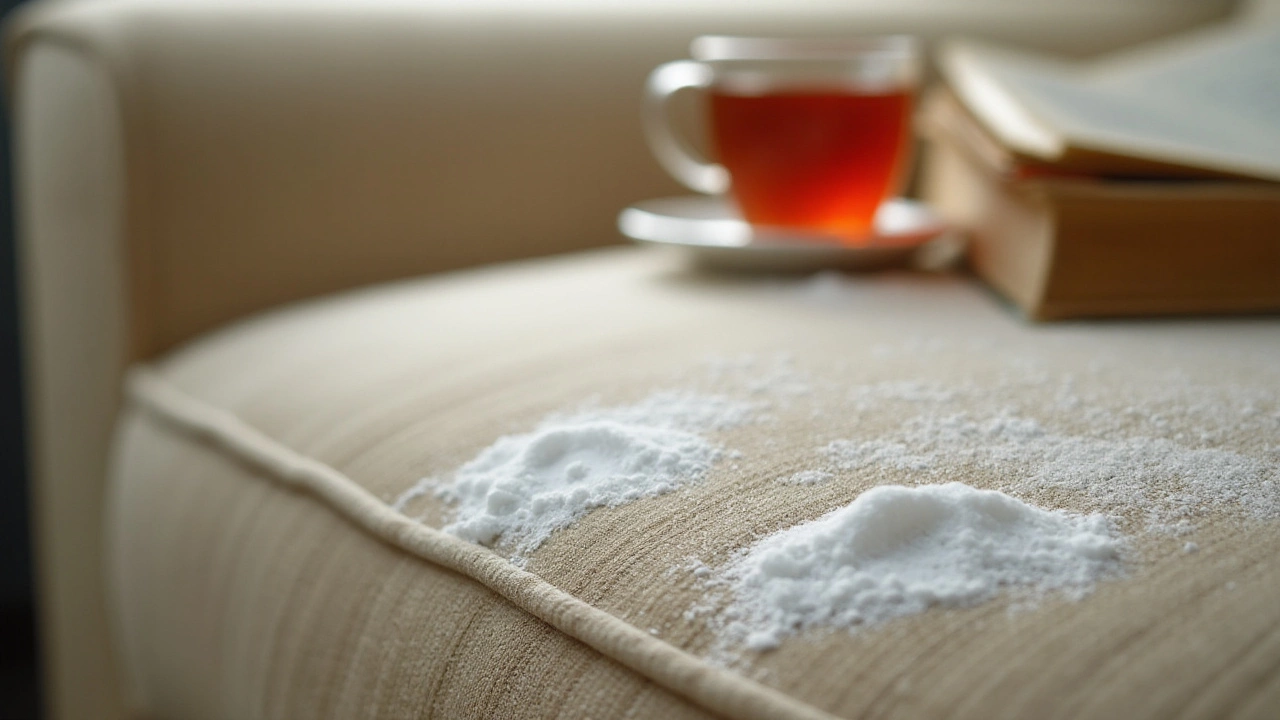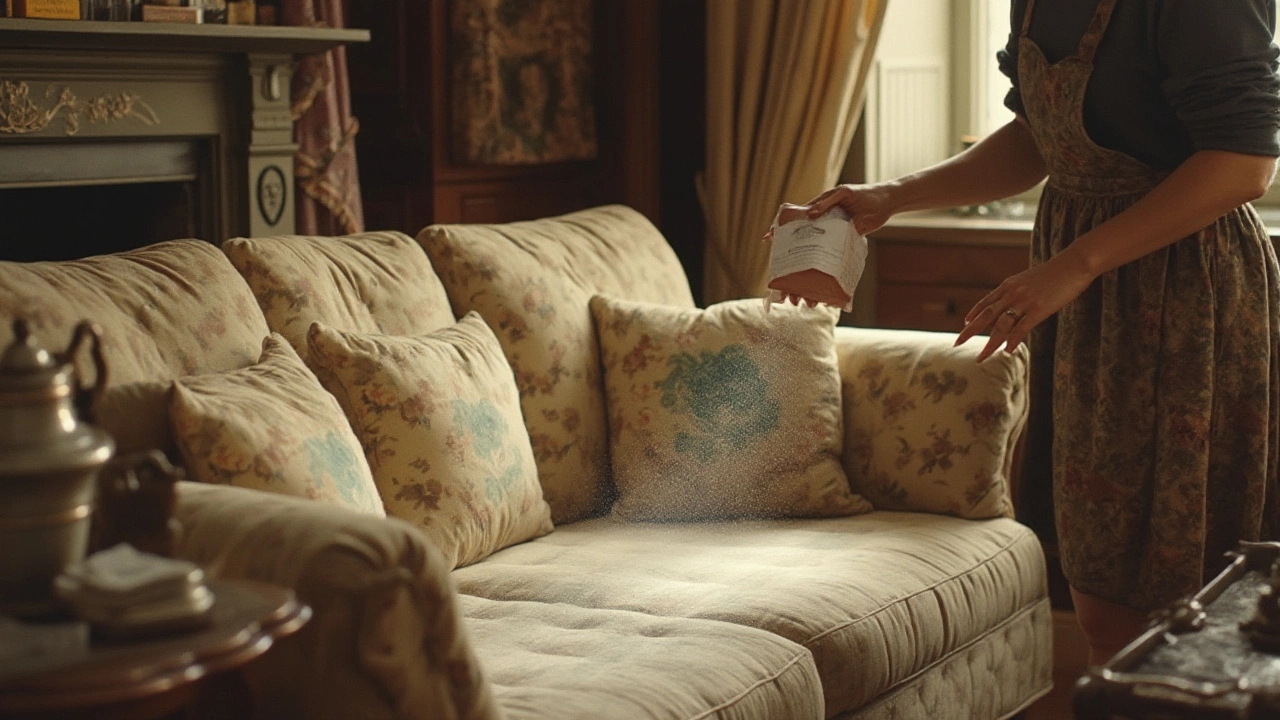When it comes to refreshing and maintaining a clean couch, baking soda is an ally many folks may overlook. This unassuming white powder packs a powerful punch, especially when combatting stains and odors in your cherished living room furniture.
Understanding how long to leave baking soda on your couch can dramatically enhance its effectiveness, ensuring that you're getting the most out of this natural cleaner. Dive into this article for some handy insights and actionable steps to make your couch look and feel like new.
- Understanding the Cleaning Power of Baking Soda
- Steps to Prepare Your Couch for Baking Soda Treatment
- How Long to Leave Baking Soda for Best Results
- Tips for Maintaining a Fresh and Clean Couch
Understanding the Cleaning Power of Baking Soda
Baking soda, known scientifically as sodium bicarbonate, stands as a staple in most households due to its versatility and effectiveness. This powerful compound is not only used for baking but has also gained a reputation as a stellar cleaning agent, especially when it comes to couch cleaning. Its magic lies in its mild alkali nature, which allows it to break down dirt and grease easily when dissolved in water. This efficient breakdown makes it a go-to solution for many seeking to tackle stubborn stains without resorting to harsh chemicals. Moreover, the slightly abrasive texture of baking soda adds a gentle scrubbing action, which makes it perfect for reaching deep into upholstery fibers, drawing out dirt and residue.
"In upholstery cleaning, baking soda is often hailed as a miracle worker," notes home cleaning expert Jessica Sampson from Clean Living Magazine. "Its ability to deodorize and tackle tough stains naturally is unsurpassed by many commercial products."
A critical component of baking soda's cleaning prowess is its ability to neutralize odors. This is particularly advantageous for pet owners or those who entertain frequently, where a myriad of scents can permeate the fabric of couches. Unlike air fresheners that only mask odors, baking soda eliminates them entirely, attacking the acidic molecules that cause unpleasant smells and neutralizing them right at the source. This ensures your furniture not only looks clean but smells refreshingly fresh.
Recent studies also highlight baking soda's role in maintaining a healthier indoor environment. Due to its prowess in dust control, applying baking soda to upholstery can help minimize dust levels, which contributes to cleaner air quality in your living space. This is especially beneficial for individuals with allergies or respiratory concerns, making a routine sprinkle of baking soda a proactive health measure as much as a cleaning task. When integrated into your standard cleaning routine, baking soda can thus be an integral part of not only maintaining your upholstery but also in enhancing your overall quality of life. So, the next time you set out to tackle those discolored patches or lingering odors on your couch, consider reaching for this humble hero right from your pantry.
Steps to Prepare Your Couch for Baking Soda Treatment
Preparing your couch for a baking soda treatment is an exercise in both care and attention to detail. The process starts with having a good look at the couch's current state. Examine the fabric and cushions closely, identifying any particularly dirty spots or stubborn stains. It might come as a surprise that your couch harbors quite a lot beneath the surface — dust, crumbs from movie nights, and even occasionally forgotten trinkets like spare change or the remote. Begin by thoroughly vacuuming your couch; make sure to use the upholstery attachment to access tight crevices.
Next, consider the type of fabric you're dealing with. Different materials react differently to cleaning agents, baking soda included. Natural fibers like cotton or linen will generally hold up well under most cleaning treatments, but delicate fabrics such as silk might require a more careful approach. If you're uncertain, consulting the manufacturer's guidelines or conducting a spot test on an inconspicuous area of the couch can prevent any mishaps. When in doubt, as quoted from the fabric care experts at Good Housekeeping,
"A quick test on the hem or under the cushions can be your best insurance against tragedy."
With your couch vacuumed and fabric type in mind, gather your supplies. You will need a box of fresh baking soda, a soft-bristled brush, and a clean cloth or towel. Sprinkle the baking soda liberally over the couch's surface. This is where magic can happen — baking soda will not only help lift light dirt but also absorb odors that tend to cling to fabric surfaces. Some old-school homekeepers even claim that letting it sit longer, overnight if possible, can tackle deeply embedded smells.
It's important to not view this as a singular, hurried task but rather a thoughtful maintenance routine. Once you’ve sprinkled the baking soda, use the soft brush to gently work it into the fabric areas that see the most use — think of spots where hands and heads rest. Be conscious not to overbrush as this might damage the material. After letting the powder work its wonders, employ the vacuum again, this time to remove the soda, which by now has hopefully taken some of your couch’s grime with it!

How Long to Leave Baking Soda for Best Results
Leaving baking soda on your couch for the right amount of time can make a world of difference in tackling stubborn stains and lingering odors. Generally, it's recommended to allow baking soda to sit on upholstery for at least 15 to 30 minutes. However, for more severe stains or noticeable smells, leaving it on overnight can provide better results. This extended period gives the baking soda time to penetrate deeper into the fibers, lifting out dirt, oil, and any unwanted scents.
Timing isn't the only important factor. Other aspects, like the type and color of your couch fabric, can influence the duration. Delicate materials such as silk might only withstand shorter exposure, whereas more robust fabrics like cotton or polyester can endure a longer application. This way, the fabric absorbs the cleaning agent effectively without risking damage. Many cleaning experts agree that testing a small, inconspicuous area of the couch first is wise. As
cleaning authority Maria Vale suggests, "Always patch test in hidden spots to ensure your couch doesn’t react adversely."
After setting the baking soda on the couch for the optimal duration, vacuuming effectively is crucial. Gently removing all the powder ensures that no residue is left behind, which might otherwise attract dirt over time. To enhance your routine, using an upholstery attachment can help get into every nook and cranny. You may even want to consider a second vacuum pass to capture any remaining debris.
Additionally, you can boost the deodorizing power of baking soda by mixing it with some essential oils. A few drops of lavender or tea tree oil can offer a pleasant aroma while breaking down tough odors as they sit together on the fabric. When you finally vacuum, your couch not only will look fresher but smell delightful. This little extra effort goes a long way in maintaining a couch you'd be proud to invite guests to sit on.
After the couch cleaning process, taking steps to prevent future staining can prove beneficial. Protective covers or fabric sprays help repel stains and keep your couch cleaner for longer. Occasional routine cleanings can also be your best friend, ensuring stains never get a chance to settle in, and baking soda continues to work its charm with less effort required.
Tips for Maintaining a Fresh and Clean Couch
Keeping your couch clean and fresh can significantly enhance the ambiance of your living space. A well-maintained piece of furniture not only looks inviting but also extends its lifespan. To achieve this, you need to integrate regular cleaning practices into your routine. Simple actions such as vacuuming the upholstery every week can prevent dust and dirt from embedding deep into the fabric. This routine task is essential as it helps remove allergens and keeps the material looking crisp and bright. Vacuum carefully along the crevices and underneath cushions to ensure every nook and cranny is covered, effectively safeguarding your couch against unnecessary wear and tear.
Another critical aspect of couch maintenance is addressing stains quickly with baking soda. As much as we'd like to keep accidental spills at bay, they are part and parcel of everyday life. The faster you tend to a stain, the better. Start by blotting the excess liquid with a clean cloth, then apply baking soda generously over the spot. Let it sit for at least 15 minutes to absorb any lingering moisture or odors. A helpful tip is to mix a small amount of dish soap with water and gently scrub if you have tougher, set-in stains. Remember, the less moisture you introduce, the quicker the drying process.
Odors have a way of creeping into your couch fabric, and if left unchecked, they become a persistent issue. One effective way to tackle unpleasant smells is by regularly sprinkling baking soda over your couch. Let it sit for several hours, allowing it to pull any unwanted scents from the fibers. Vacuum the residue and enjoy the refreshed aroma of your space. This technique is especially useful for homes with pets, as pet odor can become intertwined with upholstery fibers. Also, try using a portable air purifier nearby to help maintain a clean air flow around your sitting area.
"Consistent care with fundamental cleaning practices is key to preserving the life and look of your upholstery," advises fabric specialist Martha Seymour, who has over two decades of experience in textile care.
If you are intent on taking your couch maintenance to the next level, consider professional cleaning services. Although some people see it as an investment, professional cleaning can enhance the vibrancy and resilience of your upholstery fabric. Experts often use advanced cleaning solutions that are not readily available to the public, giving your couch deeper cleaning while being gentle on the fabric. Consider this every year or two, depending on how frequently the couch is used.
Creating and following a regular cleaning schedule can be greatly beneficial. Here’s a simple schedule to maintain your couch:
- Weekly: Vacuum and check for stains.
- Monthly: Steam or shampoo the upholstery if needed.
- Quarterly: Apply fabric protector spray.
- Annually: Hire a professional cleaner.
Following these practical tips will not only preserve the beauty of your couch but also create a healthier living environment. Maintaining cleanliness is a continuous effort that pays off with the enduring appeal of a favorite relaxation spot. A fresh and inviting couch means a cozy space for gatherings, rest, and precious life moments.
